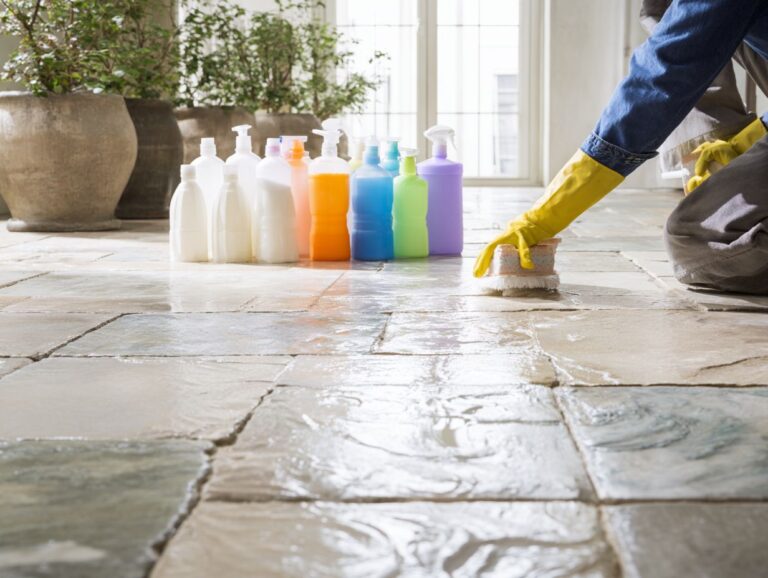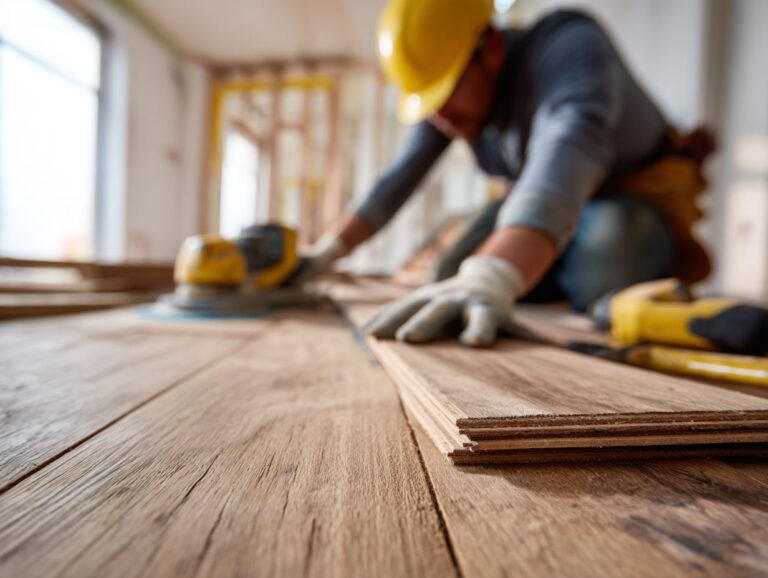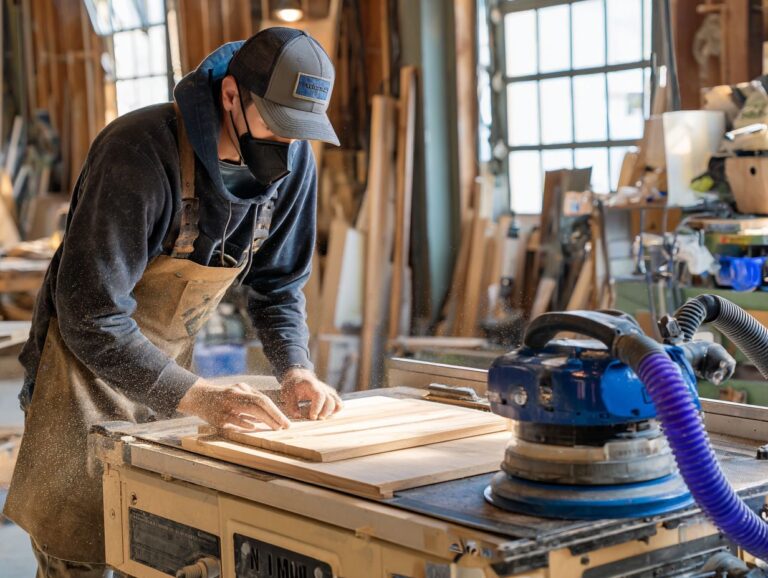Seasonal Flooring Maintenance Checklist
Contents
- Introduction to Seasonal Flooring Maintenance
- Spring Maintenance Checklist
- Summer Maintenance Checklist
- Fall Maintenance Checklist
- Winter Maintenance Checklist
- General Maintenance Tips
- Floor Cleaning and Resilient Flooring Market Statistics
- Final Thoughts
- Frequently Asked Questions
- What is a seasonal flooring maintenance checklist?
- Why is it important to have a seasonal flooring maintenance checklist?
- What are some examples of tasks that may be included in a seasonal flooring maintenance checklist?
- When should I use a seasonal flooring maintenance checklist?
- Do I need to hire a professional to complete the tasks on a seasonal flooring maintenance checklist?
- Can I create my own seasonal flooring maintenance checklist?
Introduction to Seasonal Flooring Maintenance
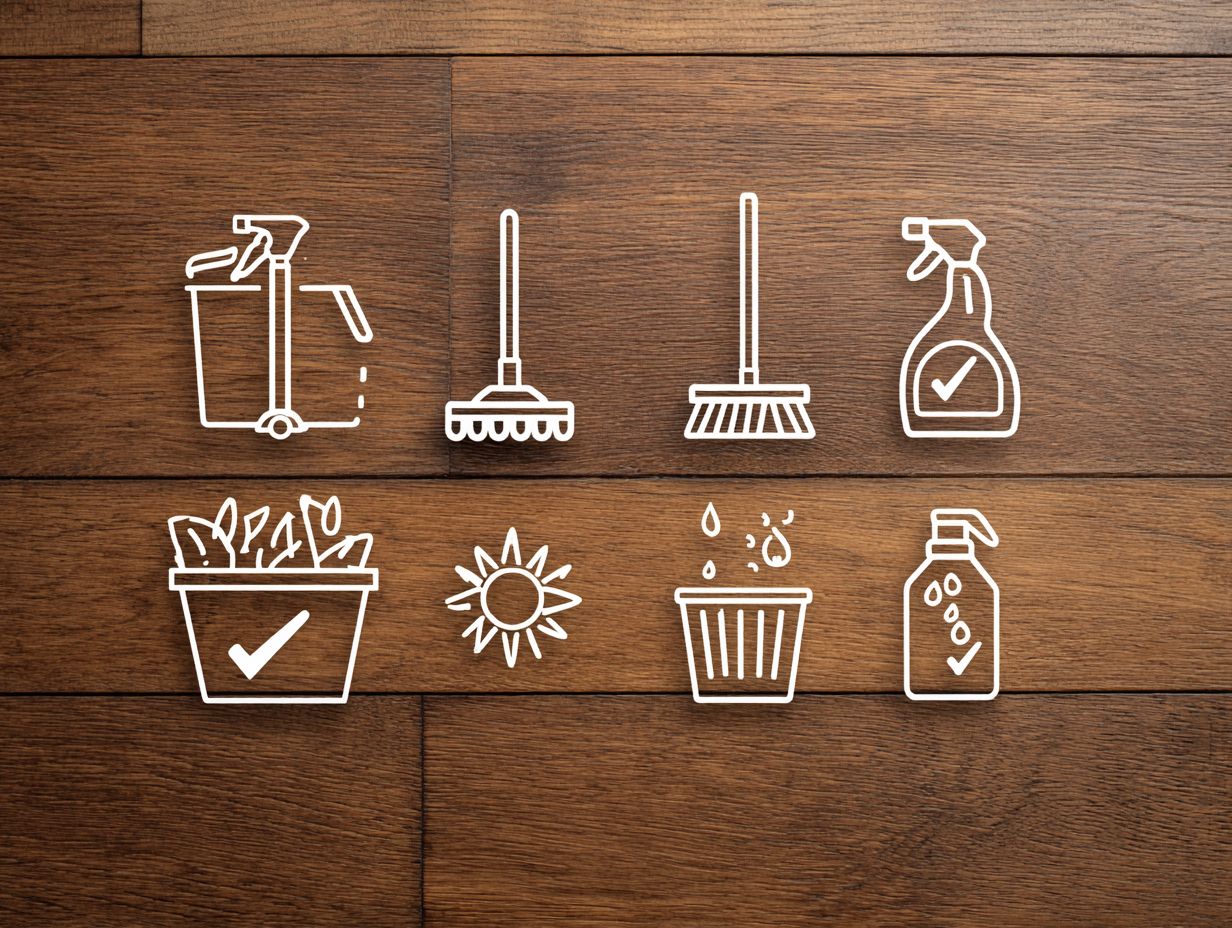
Key Takeaways:
Importance of Regular Maintenance
Regular maintenance can increase the longevity of hardwood floors by up to 30%, saving homeowners thousands in potential repairs.
To effectively maintain hardwood floors, follow these three key steps:
- First, clean regularly using a soft-bristle broom or a vacuum with a hardwood setting to prevent dust and debris buildup.
- Second, use a pH-balanced cleaner specifically designed for hardwoods-this helps avoid damage caused by harsh chemicals, as mentioned in our guide on green cleaning solutions for flooring.
- Consider applying a protective finish every few years to reduce scratches and wear.
Spending a few hours each season on these tasks will keep your floors looking good and lasting a long time.
Overview of Seasonal Tasks
A complete seasonal maintenance checklist includes tasks that keep hardwood flooring in top condition and looking good all year round.
-
In spring, focus on deep cleaning by sweeping and mopping with a pH-neutral cleaner.
-
In summer, protect against sun damage by using blinds or curtains to limit direct sunlight.
-
As fall arrives, inspect for any gaps or scratches and apply a wood filler if necessary.
-
During winter, maintain moisture balance by using a humidifier to prevent the wood from drying and cracking.
Following these seasonal tasks helps in prolonging the life of your hardwood floors while keeping them looking their best. Understanding the differences between engineered and solid hardwood is also crucial, as each type has unique maintenance needs.
Spring Maintenance Checklist
Spring is a great time for a thorough cleaning and upkeep routine to refresh your hardwood flooring after winter use.
Deep Cleaning Procedures
A deep cleaning routine should include using a pH-balanced hardwood floor cleaner, such as Bona (approximately $25), to preserve the floor finish.
- Start by sweeping or vacuuming the floor to remove dust and debris, ideally spending 15-20 minutes on this step.
- Next, use the Bona cleaner with a damp mop: spray a little on a small area and wipe with a microfiber cloth, taking 30-40 extra minutes to clean everything thoroughly.
- Improve the gloss and protection of your floors by using a product like a hardwood floor conditioner, which might need an additional 15-30 minutes.
The entire process should take about 1-2 hours depending on your space.
Inspecting for Damage
Inspecting for damage involves a thorough check for scratches, dents, and any signs of wear that may have occurred over the winter months.
- Start by examining surfaces closely, using a magnifying glass to spot fine scratches that may not be immediately visible.
- Use a damp cloth to wipe down all areas, ensuring you can identify any moisture damage.
- Next, assess the quality of any floor finishes, checking for discoloration or peeling.
List your findings to prioritize repairs by their importance and urgency.
For more extensive damage, consider consulting a professional for repair options, which may include refinishing or replacement, depending on the condition.
Moisture Control Measures
Implementing moisture control measures can prevent wood damage, especially in areas with fluctuating humidity levels during spring.
Start by using a dehumidifier, which typically costs around $200, particularly in damp areas to maintain ideal humidity levels.
Regularly check indoor humidity with a hygrometer; keeping it between 30-50% is optimal for wood integrity.
If your basement or crawl space is prone to moisture, consider installing moisture barriers, which can be a worthwhile investment to mitigate water vapor seepage.
By using these methods together, you can greatly improve your home’s protection against wood damage during unexpected spring weather.
Summer Maintenance Checklist
Summer maintenance involves shielding floors from sun damage and controlling moisture levels to stop floors from bending.
UV Protection Strategies
Using UV-blocking window films can help reduce sun damage to hardwood floors, preserving their finish and color over time.
These films can be easily installed by following a few steps.
- Begin by measuring the windows exactly to find out the amount of film required.
- Then, clean the windows thoroughly to remove dust and debris.
- Next, peel off the backing from the film and carefully apply it, smoothing out any bubbles with a squeegee.
Products like Gila Window Film offer various styles and levels of UV protection, with costs averaging $10-$30 per window.
Using area rugs in sunlit spaces helps with protection, and moving furniture to create shade can reduce direct sunlight exposure. If you’re interested in exploring more ways to protect your floors, check out our hardwood floor cleaning guide for daily, weekly, and deep cleaning strategies.
Regular Cleaning Routines
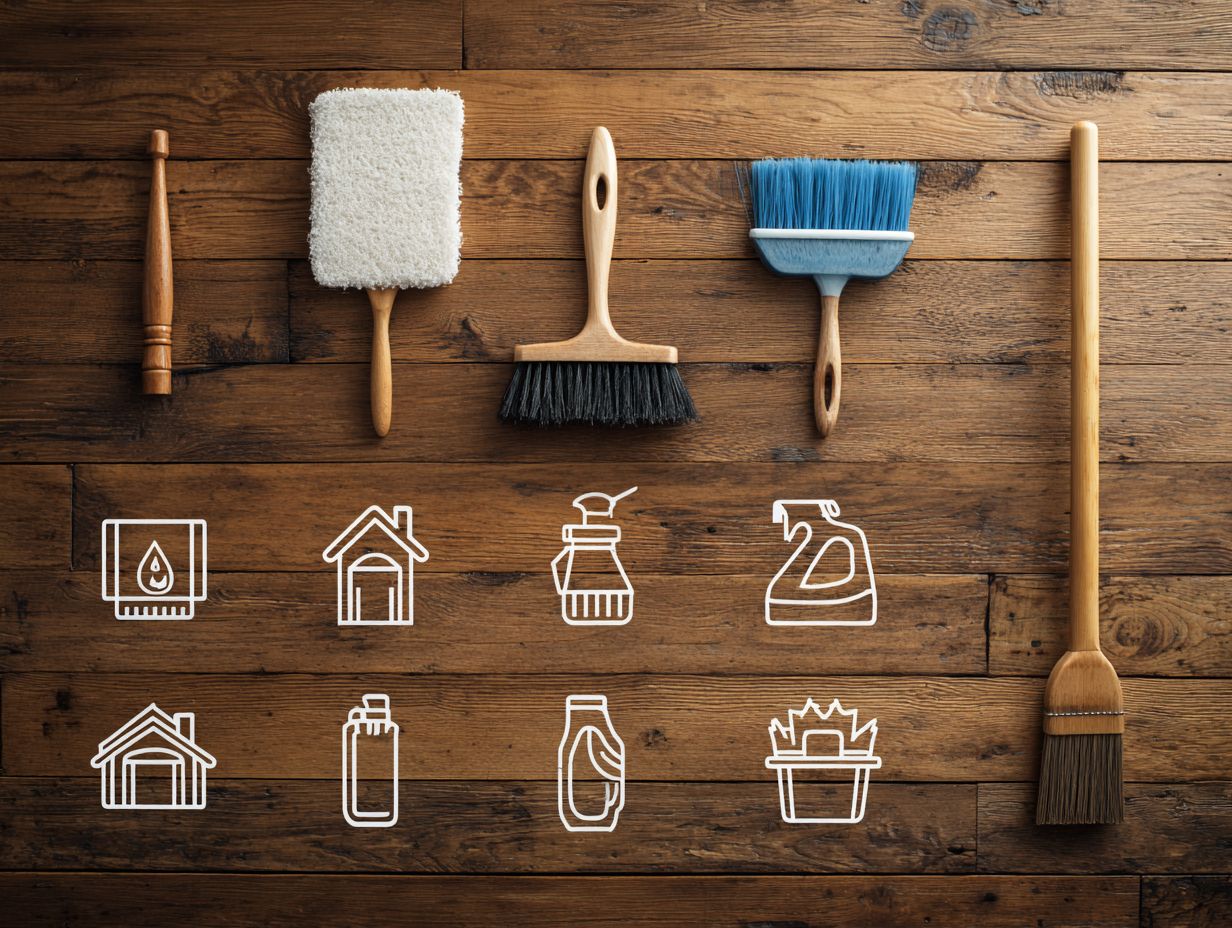
A regular cleaning routine should include vacuuming at least once a week and following up with a damp mop to prevent dirt accumulation.
Start by using a vacuum designed for hardwood floors, such as the Shark Navigator, which effectively traps dust without scratching the surface.
After vacuuming, choose a damp mop and a cleaner specifically formulated for hardwood, like Bona Hardwood Floor Cleaner, to avoid damage.
Make sure to inspect corners and edges for overlooked dirt. If you notice heavy buildup, allocate time midweek for a deep clean, ensuring your floors stay in pristine condition while extending their lifespan.
Humidity Management
Managing indoor humidity is essential during summer to prevent hardwood flooring from warping or cracking.
Start by using air conditioning to maintain a comfortable indoor temperature; setting it to 72 degreesF is ideal for both comfort and humidity control.
On particularly humid days, keep windows closed to prevent outside moisture from entering. To stay informed about your indoor environment, invest in a hygrometer, which usually costs around $10.
Regularly check the readings, aiming for a humidity level between 30% and 50%. These steps will help preserve the integrity of your hardwood floors while enhancing your home’s overall comfort.
Fall Maintenance Checklist
As the leaves change, fall maintenance readies your hardwood flooring for the tougher winter conditions ahead.
Preparing for Winter
Preparing for winter involves using protective mats and rearranging furniture to minimize stress on your hardwood floors.
Consider applying a fresh coat of finish to protect against moisture and wear. Take time to choose a high-quality product, such as Bona Traffic HD, which offers durability and a beautiful finish.
Allow for adequate drying time, as this step can significantly extend the life of your floors. Moving heavy furniture onto felt pads can reduce pressure on the wood. These steps keep your hardwood floors in good condition and make your home cozy and safe in winter.
Inspecting for Wear and Tear
Inspecting for damage every three months can identify issues early, preventing costly repairs.
To complete a full inspection, follow these steps:
- Begin by looking for visible scratches and dents on the exterior.
- Next, check for loose boards, which can compromise structural integrity.
- Inspect gutters and downspouts for blockages that might cause water damage.
- If you find significant damage or if the structure is over ten years old, schedule a professional inspection, which typically costs around $150.
This proactive maintenance will extend the lifespan of your property and save you money in the long run.
Cleaning and Conditioning
Cleaning and conditioning your hardwood floors in the fall can prepare them for the stress of winter and keep them looking new.
- Start by sweeping or vacuuming to remove loose dirt, then clean the floors using a gentle hardwood cleaner like Murphy’s Oil Soap, which costs around $5.
- After cleaning, apply a conditioner such as Bona Hardwood Floor Conditioner for about $15 to nourish and protect the wood. Make sure you let each step dry fully to get the best results from the products.
Regular maintenance in the fall helps extend the life of your floors and keeps them radiant throughout winter.
Winter Maintenance Checklist
Winter maintenance helps protect hardwood floors from snow, ice, and indoor humidity fluctuations that can cause damage.
Snow and Ice Management
It’s important to manage snow and ice to avoid moisture damage. Using ice melt products without salt can protect your hardwood floors.
Plus using salt-free ice melt, consider installing rubber mats at entryways to trap moisture before it spreads. These mats provide a non-slip surface and can often be found at local home improvement stores.
Quickly wiping up any snow or water brought inside keeps your floors dry and lowers the chance of slipping. In very damp situations, a dehumidifier can help manage moisture levels, which protects your hardwood from water damage.
Indoor Humidity Control
Maintaining indoor humidity levels between 30% and 50% in winter is essential to prevent hardwood from warping.
To do this, buy a dependable humidifier. The Honeywell HE360A, priced at about $50, is good for adding moisture to big areas.
Pair this with a hygrometer to monitor humidity levels; affordable choices like the AcuRite 00613 can be found for under $20.
To keep indoor humidity in check, open windows when it gets high; this easy step can help keep the air balanced.
Regularly adjusting your humidifier settings based on readings will keep your environment comfortable while protecting your hardwood flooring.
Routine Inspections
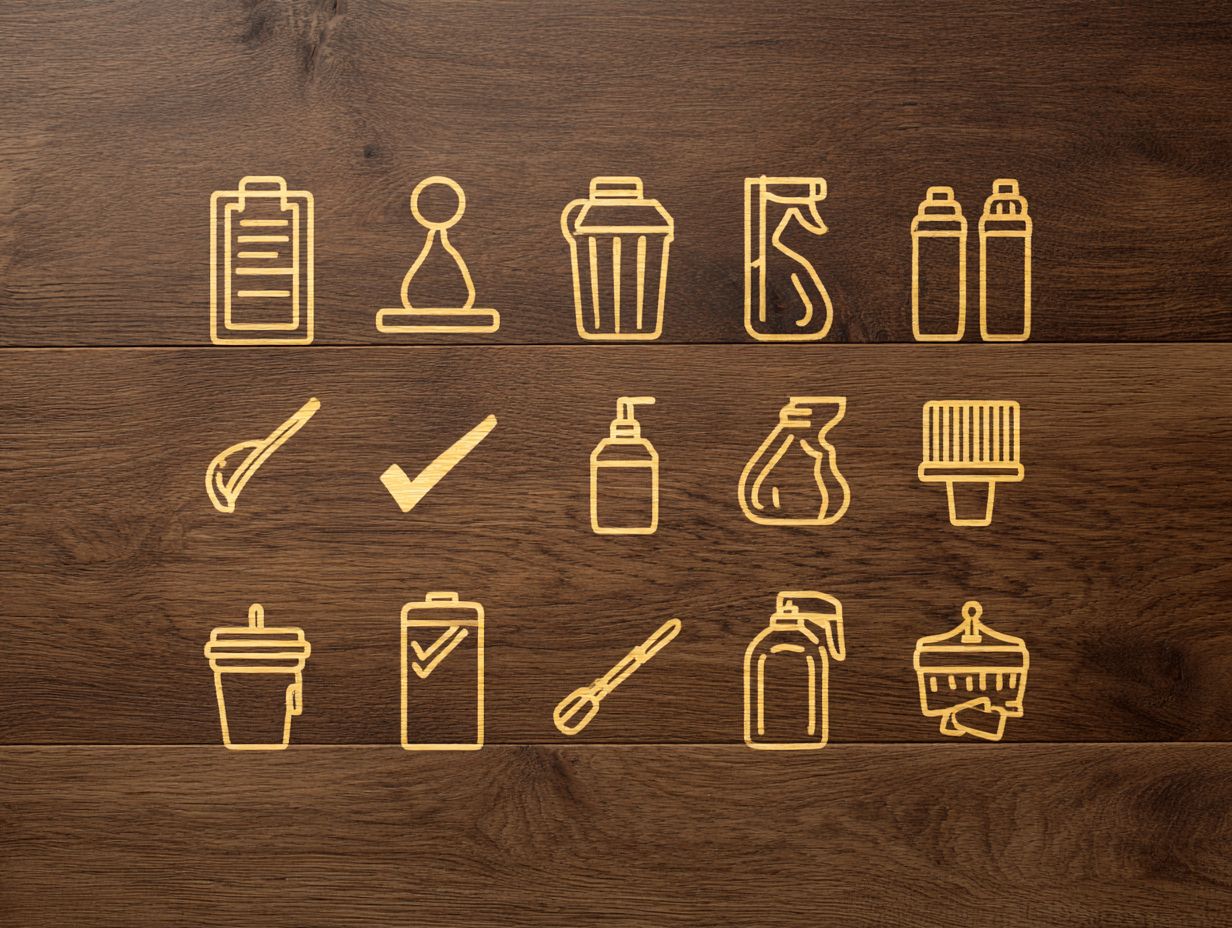
Routine inspections during winter can help catch issues early, preventing expensive repairs from moisture damage.
- Start by examining your roof for missing shingles and any signs of ice damming, which can lead to leaks.
- Next, check gutters for any clogs; remove debris to allow water to drain correctly.
- Inspect your basement and crawl spaces for any signs of moisture or water pooling.
- Check your home’s ventilation systems to make sure they are working well and lowering humidity.
If you notice any concerning signs, consider scheduling a professional inspection. This proactive approach can save you money in the long run and maintain your home’s integrity.
General Maintenance Tips
Basic care advice is important for maintaining hardwood floors in good shape year-round.
Choosing the Right Cleaning Products
Choosing the right cleaning products is fundamental; look for pH-balanced cleaners specifically designed for hardwood flooring, like Zep Hardwood Floor Cleaner ($10).
Plus Zep, consider Bona Hardwood Floor Cleaner ($13), which is biodegradable and safe for regular use.
For tougher stains, Black Diamond Wood & Laminate Floor Cleaner ($12) effectively tackles grime without leaving residues.
Make sure to try out any new product on a hidden spot of your floor first to check if it works well.
To keep your floors in good condition, dust or vacuum them often to avoid scratches. Use a slightly wet mop instead of a very wet one for the floors.
Floor Cleaning and Resilient Flooring Market Statistics
Floor Cleaning and Resilient Flooring Market Statistics
Floor Cleaning Maintenance Market: Overall Market Size
Floor Cleaning Maintenance Market: Key Regional Growth
Resilient Flooring Market: 2023 Market Performance
Resilient Flooring Market: LVT Segment
The Floor Cleaning and Resilient Flooring Market Statistics give a full overview of market shifts and expected growth trends for the floor cleaning, maintenance, and durable flooring industries. This information shows important details about market performance, chances for growth in different areas, and changes in specific product categories, giving a clearer view of industry directions.
The Floor Cleaning Maintenance Market is projected to grow from a $12.5 billion market value in 2023 to $20.9 billion by 2032. This reflects a healthy compound annual growth rate (CAGR) of 5.8%. The increasing emphasis on hygiene and cleanliness, especially in commercial and public spaces, drives this growth. North America and Europe lead in regional growth with 34.0% and 31.0% respectively, highlighting strong market presence and demand for floor maintenance solutions. The Asia Pacific region, with a 7.8% growth rate, indicates a rapidly expanding market owing to urbanization and increasing consumer awareness about floor care.
In contrast, the Resilient Flooring Market faced challenges in 2023, experiencing a 9.7% decline in total sales and a 7.1% volume decline, with the total sales value standing at $8.546 billion. Despite these declines, the market share remains significant in certain segments: total dollar sales account for 34.0% of the market, while total volume share is at 35.55%. Notably, hard surface flooring comprises 56.7% of dollar sales, highlighting consumer preference for long-lasting and flexible flooring choices.
The LVT (Luxury Vinyl Tile) Segment shows promising potential, with a $7.32 billion market value and an 11.4% increase in market value. The Rigid Core subcategory, boasting a 57.5% market share “”, shows strong demand because it is long-lasting, looks good, and is easy to put in place. The growth in the LVT market shows new developments and changes in products, meeting changing customer tastes and the need for durable flooring.
Overall, these statistics highlight a changing market where there are chances for growth in the floor cleaning sector, while the resilient flooring market faces certain difficulties. Concentrating on new ideas, growing in different areas, and creating products that meet customer needs could lead to success in both markets.
Tools for Effective Maintenance
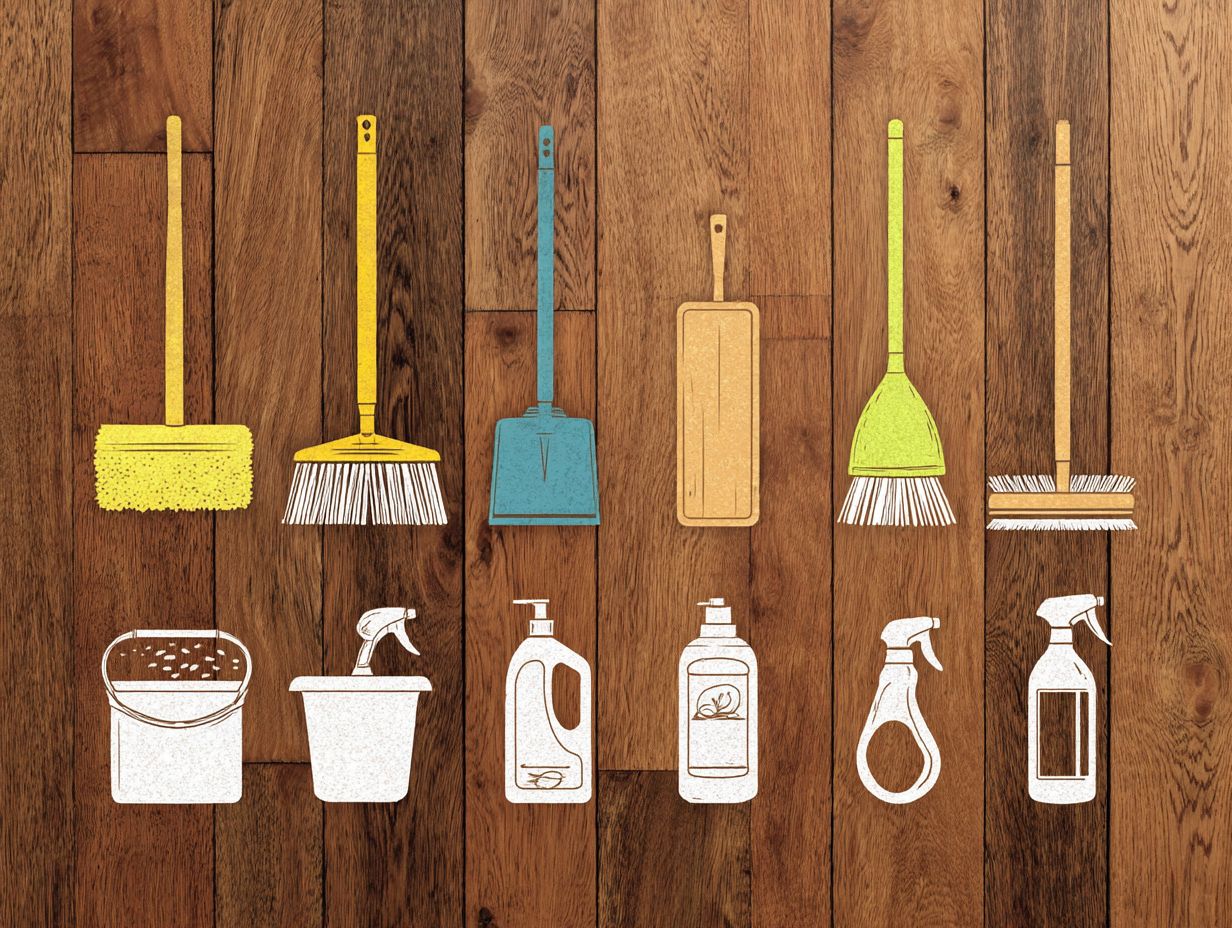
Choosing the right tools can make a big difference in taking care of your hardwood floors, making cleaning easier and care more efficient.
- Start with a microfiber mop, which effectively traps dirt and dust without scratching the surface, costing around $15.
- Pair this with a specialized vacuum designed for hardwood, typically priced at $150, which helps eliminate debris from crevices and corners.
- A soft bristle broom, available for about $10, is perfect for daily quick clean-ups, preventing buildup.
These tools offer a complete cleaning solution that helps keep your hardwood floors shiny and lasts longer. For additional recommendations on cleaning products that work well with different types of flooring, learn more about the best flooring cleaning products.
Final Thoughts
Setting up a maintenance plan makes sure your hardwood floors get the regular attention they need to stay attractive and strong.
Creating a Maintenance Schedule
A clear maintenance plan can simplify hardwood floor care and help avoid neglect during hectic times.
- Start by listing essential seasonal tasks such as inspection for damage, cleaning, and refinishing.
- Then, pick how you want to keep track of these tasks; online tools like Trello or Google Calendar can send alerts, while a paper planner is also effective.
- Set alerts at least one week before for jobs like inspections or cleaning, so you keep up with maintenance.
- This effective approach extends the lifespan of your flooring and improves its appearance, making it a wise investment.
When to Seek Professional Help
Getting help from a professional can save homeowners time and money. Hire a professional if you see major damage or wear.
For example, if you see cracks in your foundation or water stains on your ceilings, it may be a sign of more serious structural issues.
If you suspect moisture problems, using a moisture meter can help identify hidden leaks.
Regular inspections matter; if you see issues beyond regular use, it’s wise to consult an expert. They can find hidden issues and offer specific answers.
Remember, addressing issues early often prevents costly repairs down the line.
Frequently Asked Questions
What is a seasonal flooring maintenance checklist?
A seasonal flooring maintenance checklist is a list of tasks and actions that need to be completed in order to properly maintain and care for your flooring during different seasons of the year.
Why is it important to have a seasonal flooring maintenance checklist?
A seasonal flooring maintenance checklist helps you keep your floors in good condition all year. This can help prevent damage, extend the lifespan of your flooring, and save you money on costly repairs or replacements.
What are some examples of tasks that may be included in a seasonal flooring maintenance checklist?
Tasks that may be included in a seasonal flooring maintenance checklist can vary depending on the type of flooring, but some common ones include cleaning, resealing, and inspecting for any damage or wear and tear.
When should I use a seasonal flooring maintenance checklist?
A seasonal checklist for floor maintenance should be used at least yearly. It’s helpful to use it at the beginning of each season to get your floors ready for changes in weather or the amount of people walking on them.
Do I need to hire a professional to complete the tasks on a seasonal flooring maintenance checklist?
Some tasks on a seasonal flooring maintenance checklist, like thorough cleaning or resealing, might need a professional’s help. Still, homeowners can do a lot of tasks themselves if they have the right directions and tools.
Can I create my own seasonal flooring maintenance checklist?
Yes, you can create your own seasonal flooring maintenance checklist using your specific flooring type and the tasks recommended by the manufacturer or flooring expert. You can also use a general checklist as a guide and customize it to fit your needs.
